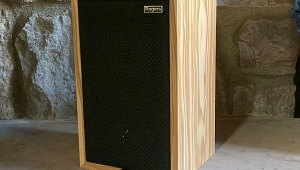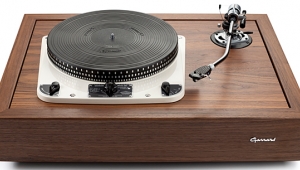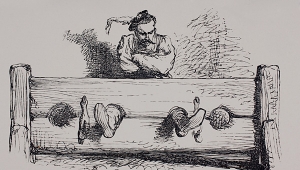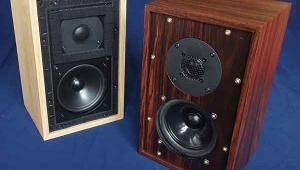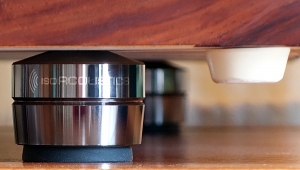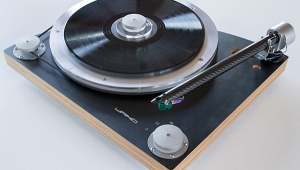| Columns Retired Columns & Blogs |
Listening #87
Even katydids are supposed, by some, to drink.—Shirley Jackson, 1959 (misheard)
Footnote 1: US distributor: Oswalds Mill Audio. Web: www.oswaldsmillaudio.com.
Review samples, once received, often wait days or even weeks before I can find the time to install them. But turntables and tonearms tend not to gather much dust. Tonearms, in particular, get the fast track.
 So it was with the Schick tonearm, made in Germany by Thomas Schick and imported by Oswalds Mill Audio, in rural Lehigh County, Pennsylvania (footnote 1). In recent months I've exchanged some e-mails with OMA's Jonathan Weiss, a nice fellow who seems active in various different artistic pursuits. I was impressed with Weiss's taste in audio gear—we both enjoy high-efficiency loudspeakers, low-power tube amplifiers, high-torque turntables, and high-mass tonearms and pickup heads—and with the very relaxed, low-pressure approach he takes in promoting his commercial products.
So it was with the Schick tonearm, made in Germany by Thomas Schick and imported by Oswalds Mill Audio, in rural Lehigh County, Pennsylvania (footnote 1). In recent months I've exchanged some e-mails with OMA's Jonathan Weiss, a nice fellow who seems active in various different artistic pursuits. I was impressed with Weiss's taste in audio gear—we both enjoy high-efficiency loudspeakers, low-power tube amplifiers, high-torque turntables, and high-mass tonearms and pickup heads—and with the very relaxed, low-pressure approach he takes in promoting his commercial products.
Most of all, I liked what I heard about Thomas Schick's transcription-length tonearm, which sells for a mere $1475. I was happy just to know that such a thing could exist, if not quite flourish, in 2010.
Larks, too
In one of the many compelling observations on his own website, Herr Schick says he intended his tonearm to combine the greater-than-average length and mass of certain vintage models with the high-quality bearings more typical of modern arms (footnote 2). Surely the same idea was behind the recently reissued EMT 997 12" tonearm ($4995; see the July 2008 edition of this column, Vol.31 No.7), a sample of which I bought and continue to enjoy. But at less than a third of the price, the Schick would seem poised for even greater popularity among this subset of phonograph lovers, many of whom delight in maintaining different record players for different records—and to whom a new musical flavor is seldom a disagreeable thing.
Packed with my review sample of the Schick tonearm, which arrived about two weeks ago, was a small slip of paper that directed my attention to the installation manual on Schick's website: excellent photos and clear descriptions of each key step, in acceptably good English. I followed Schick's instructions to the letter, even taking his advice to make my own wooden template for locating the arm-mount hole at the correct spindle-to-pivot length: 304.8mm, which is German for 12".
The armboard for the Thorens TD-124 thus drilled, the collet thus mounted, I removed the Schick arm from its neat wooden box and undid the tie that binds it together for shipping. I gently took hold of the armtube and tried to move it away from the neat wooden armrest—and was prevented from doing so by a level of friction so high as to impede all but the least subtle movements.
I was concerned that the Schick arm might have been damaged in shipping. Yet as I continued to gently move the arm back and forth, I realized that the armtube's movement was being impeded by the height-adjustable gantry to which the armrest was mounted, which had been snugged up too close to the rotating bearing housing. Once I'd loosened the appropriate locking bolt and lowered the gantry, it became obvious that the bearings themselves were fine—excellent, in fact.
That bit of drama out of the way, I carried on with the installation. Unlike my EMT 997, the Schick is hardwired with its own shielded cable—a boon to anyone who dislikes soldering, and a blessing in any household where interconnects are always in short supply. Setup was further streamlined by the Schick's lack of an antiskating device, which was perfectly fine with me. (After listening both with and without it, I decided to store my EMT's antiskating mechanism in the carton—a point to which I'll return in a moment.) The playing end of the Schick's armtube has a four-pin, SME-standard electrical socket with the usual sort of mechanical locking collet, while the other end is nothing more than a plain, sealed metal tube. The latter is meant to carry one of two supplied counterweights, which can be locked in place with a small setscrew after the downforce has been adjusted.
Apart from a slightly rough wooden armrest, the Schick's build quality is superb. Its bearing cradle is spare and cleanly made, and the bearings themselves are at the same lofty level as those of the EMT 997, with even less play—and no detectable friction. For their part, the Schick's pickup head socket and its locking collet mechanism felt better than the ones in the more expensive arm: Pickup heads locked in place smoothly and positively, with a little less slop.
Footnote 1: US distributor: Oswalds Mill Audio. Web: www.oswaldsmillaudio.com.
Footnote 2: And where such a thing did exist in the past, its condition would surely have deteriorated by now. Like a 1930s-era Martin guitar with an optimal neck angle or a Jaguar XK140 that starts on cold mornings, a reasonably priced vintage transcription tonearm that performs as well as a modern one in every way would be quite the thing.
- Log in or register to post comments


